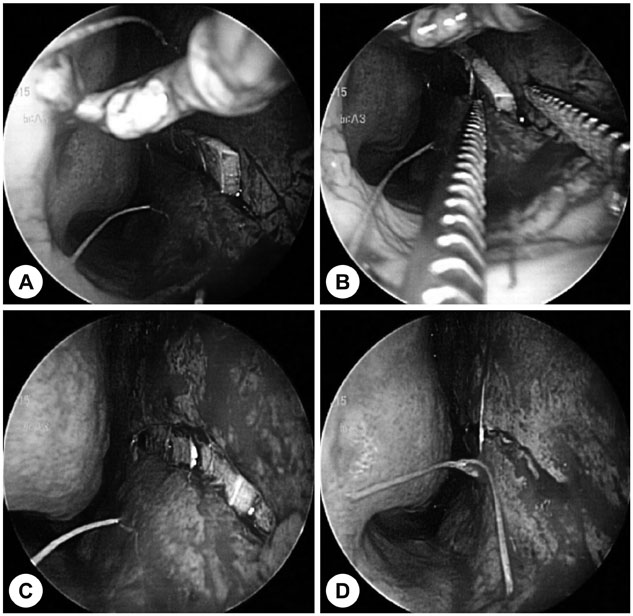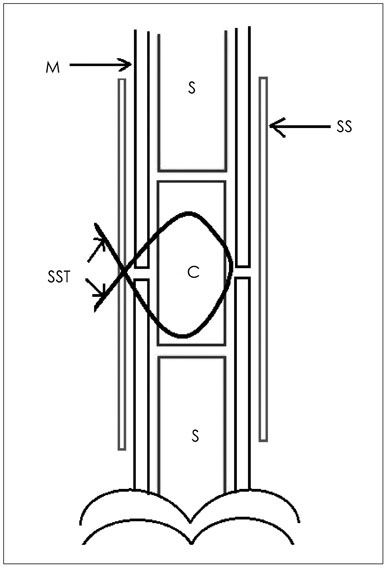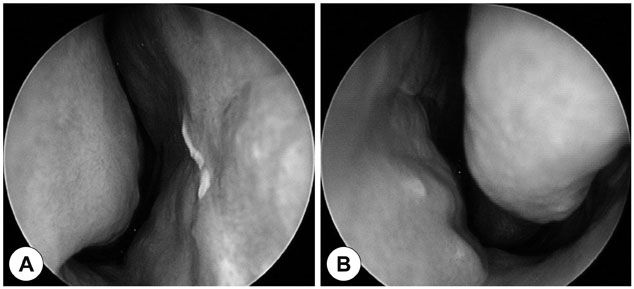J Rhinol.
2018 May;25(1):21-25. 10.18787/jr.2018.25.1.21.
A Securing Suture Technique of Autologous Cartilage for the Prevention of Septal Perforation during Septal Surgery
- Affiliations
-
- 1Department of Otolaryngology-Head and Neck Surgery, Institute of Wonkwang Medical Science, College of Medicine, Wonkwang University, Iksan, Korea. leejaehoon64@gmail.com
- KMID: 2412916
- DOI: http://doi.org/10.18787/jr.2018.25.1.21
Abstract
- BACKGROUND AND OBJECTIVES
Septoplasty is a commonly performed operation in otolaryngological practice. In cases of septal mucosal tearing, septal perforation can easily occur. The aim of this study was to investigate patients who underwent an autologous cartilage securing suture technique to prevent nasal septal perforation.
SUBJECTS AND METHODS
A total of 403 patients who underwent septoplasty alone or with endoscopic sinus surgery for the past three years were enrolled in this study. Septal mucosal tearing occurred in 27 patients. In group 1 (15 patients), autologous cartilage was inserted between the injured mucosa. In group 2 (12 patients), autologous cartilage was inserted between the injured mucosa with a securing suture technique. We investigated the septal perforation rate between the two groups.
RESULTS
In group 1, septal perforation occurred in 7 of 15 patients (46.6%) and in group 2 there were no perforations. The occurrence rate of perforation in group 2 was significantly lower than that in group 1 (p<0.01).
CONCLUSION
The securing suture technique of autologous cartilage can be an effective method for prevention of septal perforation during septal surgery.
MeSH Terms
Figure
Reference
-
1. Fairbands DN, Fairbanks GR. Nasal septal perforation: prevention and management. Ann Plast Surg. 1980; 5(6):452–459.
Article2. Yun DH, Kim YJ, Kim JH, Lee BJ. Causes and characteristic of the nasal septal perforation. J Rhinol. 2000; 7(1):64–68.3. Kridel RW. Septal perforation repair. Otolaryngol Clin North Am. 1999; 32(4):695–724.
Article4. Choi YS. Diagnosis and treatment of nasal septal perforation. Korean J Otolaryngol-Head Neck Surg. 2006; 49(6):586–592.5. Lee JY, Lee SW, Lee JD, Lee YM, Shin JM, Lee JY. Usefulness of autologous cartilage and fibrin glue for the prevention of septal perforation during septal surgery: a preliminary report. Korean J Otolaryngol-Head Neck Sur. Korean J Otolaryngol-Head Neck Surg. 2006; 49(6):611–615.6. Choi JS, Jin KH, Park MW, Kang SH, Lim DJ, Yu MS, et al. Prevention technique using inferior turbinate mucosal flap for septal perforation after septoplasty. J Rhinol. 2014; 21(1):37–40.7. Hong SK, Min YG. Repair of nasal septal perforation by intranasal approach using a free composite graft of the auricular cartilage and the temporalis muscle fascia. Korean J Otorhinolaryngol-Head Neck Surg. 2002; 45(10):969–974.8. Kuriloff DB. Nasal septal perforation and nasal obstruction. Otolaryngol Clin North Am. 1989; 22(2):333–350.9. Butz DR, Warner J. Transcutaneous securing technique for nasal onlay grafts. JAMA Facial Plast Surg. 2015; 17(2):149–150.
Article
- Full Text Links
- Actions
-
Cited
- CITED
-
- Close
- Share
- Similar articles
-
- Prevention of Septal Perforation During Septal Surgery Using Inferior Turbinate Mucosa and Fibrin Glue
- Usefulness of Autologous Cartilage and Fibrin Glue for the Prevention of Septal Perforation during Septal Surgery: A Preliminary Report
- Prevention Technique Using Inferior Turbinate Mucosal Flap for Septal Perforation after Septoplasty
- Optimal harvest and efficient use of septal cartilage in rhinoplasty
- Two Cases of Septal Perforation Repair using Posterior Margin Based Hinge Flap





